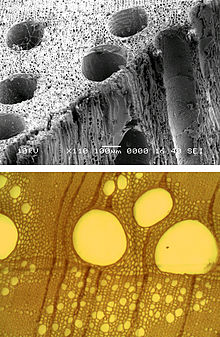Trachee (plant)
In botany , the term trachea describes a vascular element of the xylem that is located in the vascular bundle of the shoot axis of higher plants. Flowering seed plants in the trachea transport water from the roots into the leaves . The main driving force for this is the perspiration suction , which is explained by the cohesion theory. In addition, the root pressure can play a role, e.g. B. in spring. Trachea, like tracheids, are dead, lignified cells.
In trachea, the cell walls are completely or partially dissolved in the axial direction. Several tracheal cells are connected to one another within a vessel, so that a long, continuous tube is formed compared to tracheids. The totality of the trachea (together with the tracheids) thus forms a continuous and communicating tube system from the roots to the leaves.
In the transverse direction, water can be transported across pits . The pits of the bedecktsamer (angiosperms) are more simply structured than the court pits of the torus-margin type of the naked pits (gymnosperms). The potted membrane of the trachea consists of a network-like tangled network of microfibrils. The very small “meshes” of the speckled membrane prevent the gas phase from spreading in the event of an embolism, since the menisci that develop can withstand very high pressures at the water-gas boundary ( Young-Laplace equation ). However, if the pressure difference between the water and gas sides is too great, neighboring vessels can also be embolized. Local delimitation of embolisms can therefore probably be better achieved with gymnosperm pits, as these work like non-return valves.
One can distinguish between trachea and tracheid by examining a cross-section of a histological specimen on the axial walls of the respective vessels. Trachea also often have a significantly larger diameter. In contrast to the tracheids, they are solely responsible for the water supply. Tracheids also contribute to the mechanical stabilization of the plant (double function). With deciduous trees, additional wood fiber cells increase the mechanical stability. Due to the larger diameter, the volume flow in tracheids is significantly higher than in tracheids ( Hagen-Poiseuille's law ), but the risk of vascular embolism increases due to the tearing of the water thread . Most naked samos (gymnosperms) only have tracheids for water transport (exception: gnetales ). In contrast, most flowering plants (angiosperms) contain both tracheae and tracheid (exceptions are, for example, the Winteraceae and Trochodendraceae , which have no tracheae).
literature
- Anita Roth-Nebelsick: The principles of plant-based water pipes. In: Biology in Our Time. 2/2006 (36), pp. 110-118.
